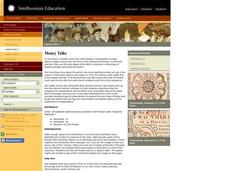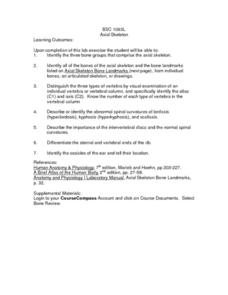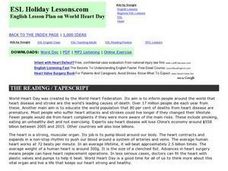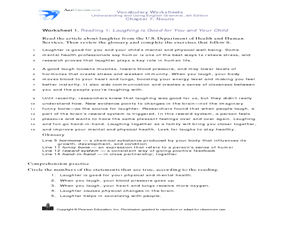Curated OER
Skin and Sports
The topic is protecting our own protective covering: the skin. In particular, the information deals with sweating as a means of temperature regulation and the need to wear clothing appropriate for allowing the process to occur. Learners...
Curated OER
Climate and Cultures of Africa
Students gain an understanding of the relationship between climate and culture in the sub- Saharan Africa. Students will complete short exercises pertaining to the various cultures of Africa and the climate in which they live....
Curated OER
Breathing
For this breathing worksheet, learners will review vocabulary words and topics relating to the lungs and the parts of the breathing system in humans. Students will explore how exercise effects the carbon dioxide that is exhaled. This...
Curated OER
What Is In The Water?
Students investigate the biotic and abiotic factors that are found in an aquatic ecosystem. The emphasis is upon the investigation of present an projections of future water quality. Then students visit a local body of water to gather...
Curated OER
Feedback and Flowcharts
Sixth graders explain what a negative feedback system is and they distinguish it from a positive feedback system. They describe examples of how negative feedback is used in both nature and technology. , Students define homeostasis, and...
Curated OER
Money Talks
Students move from fact finding to interpretation as they examine paper money from the time of the American Revolution. In the final exercise, they use the issue dates of the bills to construct a chronology of political changes during...
Curated OER
Pulse Rates
Students answer the question, "How will the intensity of exercise effect your heart rate?", using physical workouts and AppleWorks, or similar spreadsheet program. This instructional activity can conclude with the creation of a graph of...
Curated OER
Heart 2: Changing Lifestyles and Heart Health
Students examine and evaluate changes in diet and lifestyle from prehistoric to modern times and how these differences have spurred the development (and better treatment) of heart disease.
Curated OER
Cardiac Function
In this health worksheet, high schoolers look for the connections needed to attain the knowledge of cardiac function. The sheet includes the background information.
Curated OER
Axial Skeleton and Fetal Skull
In this science worksheet, students identify bone groups from a given list. Students list each bone included in the axial skeleton. Students answer questions about specific bones, their location and importance.
Curated OER
Haunted House Challenge Fitness Stations
Students rotate through ten physical fitness stations. They perform various stretching and strengthening activities for three minutes at a time.
Curated OER
Teaching With the Power of Objects
Students define value of an object. In this value lesson plan, students identify reasons for collecting objects, compile a personal inventory of items they find valuable, and then define why those items are valuable to them. In step two...
Curated OER
Learning the Dissecting Planes
Students explore dissecting planes. In this biology lesson plan, students learn the basic vocabulary used in dissection, learn how to orient themselves on a three dimensional figure, and develop the manual dexterity necessary to use...
Curated OER
Virus Tracker
Sixth graders will simulate the spread of a virus such as HIV through a population by "sharing" (but not drinking) the water in a plastic cup with several classmates. Although invisible, the water in a few of the cups will already be...
Curated OER
How Things Fly
Students, by drawing on their own experiences, discuss and examine the basic physics of flight. They participate in a variety of activities regarding flight.
Curated OER
Mapping the Homunculus
Students determine the relative number of nerve endings located in the skin. By calculating the reciprocal of these measurements, students have the appropriate data for predicting the relative size of the homunculus found on the cerebral...
Curated OER
Magnetic Discovery Bottle
Students examine how to conduct simple investigations and use simple equipment to gather data. For this magnet lesson students decide what types of objects are attracted to magnets.
Curated OER
World Heart Day
In this World Heart Day worksheet, students complete activities including reading a passage, matching phrases, fill in the blanks, correct word choosing, multiple choice, sequencing, unscramble the sentences, write questions, take a...
Curated OER
White Man's Burden:The Expansionist/Anti-Imperialist Debate at the Turn of the Century
High schoolers explore the roles of Expansionists and Anti-imperialists and take on the identity of a historical character to defend their position before a Senate committee. Roles of newsmen, senators, and futurists are also assumed in...
Curated OER
Classification of Intertidal Organisma
Students categorize animals. In this animal classification lesson plan, students group animals by their characteristics. Students break into groups and work together to classify the animals. Students fill out a graphic organizer with...
Curated OER
You Won't Believe Your Eyes!
Students gain a basic understanding of the sense of sight. They watch a video on sight, then engage in some vocabulary games, and perform some simple experiments which focus on the basics of sight.
Curated OER
Heart 1: Transplant
Students explain the workings and anatomy of the heart and to explore new medical techniques that help people live longer, healthier lives.
Curated OER
Homeostasis
Students explore homeostasis and identify it in work in an organism. They brainstorm things that stay the same and participate in several demonstrations that illustrate homeostasis. Students predict baseline breathing and jumping jacks
Curated OER
Laughing is Good for You and Your Child: Reading Comprehension
In this reading comprehension worksheet, students read a passage pertaining to laughter and then respond to 5 true or false questions regarding the passage.























